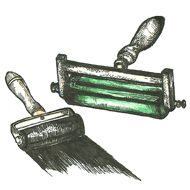
Printmaking is a great way for pupils of all ages to experiment and explore visual art.It can be applied throughout the key stages, adapted to suit different levels of ability and can encompass almost any theme or curriculum area.
Learning outcomes for printmaking include: problem solving, teamwork, communication, listening, personal reflection, debating, being objective and critical, developing own visual language and artistic interpretation. Printmaking can also develop literacy skills through encouraging critical and expressive use of language in response to the student’s observations.
Due to the ‘hands-on’ nature of printmaking, pupils will naturally develop fine motor skills. From pulling ink with a squeegee, to carving into lino, they are nurturing dexterity and the capability to manipulate materials. This hands-on approach also means pupils have a direct connection to the work they create, they can see their creations unfold before them which can often feel quite magical.
“The exploration and fascination with the endless possibilities of printmaking are at the core of my work with children. The idea that there are no wrong turns and no mistakes opens up a whole new way of working and creating which is something I truly believe in.”
Sally Gilford, Artist and Screen-Print Specialist
Printmaking is an activity which many teachers avoid due to the ‘mess’ that can occur. However, it is a fun and engaging way of teaching children a new skill.
During this session, we were able to use our evocative object to create a print. We were to focus on a specific aspect of our object and draw this in order to create our print. Once we had chosen the area we were focusing on, we had to carefully sketch an outline using a ball-point pen. Children may find this difficult as if they make a mistake they can not rub it out but must continue on with their piece of artwork. This teaches children that in life everything can not be perfect but we can still make something beautiful out of it.
Below are images of the task being implemented.







References
- Moodle.uws.ac.uk. (2017). 1617_EDUC08027_01. [online] Available at: http://moodle.uws.ac.uk/mod/resource/view.php?id=709049 [Accessed 6 Apr. 2017].
